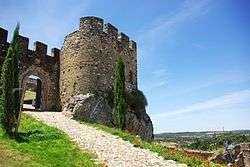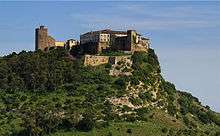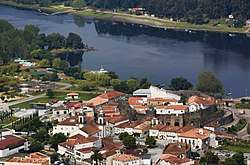Castle of Montalvão
The Castle of Montalvão (Portuguese: Castelo de Montalvão) is a medieval castle in the civil parish of Montalvão, municipality of Nisa, in the Portuguese district of Portalegre.
| Castle of Montalvão | |
|---|---|
Castelo de Montalvão | |
| Portalegre, Alto Alentejo, Alentejo in Portugal | |
| Coordinates | 39°35′44.63″N 7°31′34.69″W |
| Type | Castle |
| Site information | |
| Owner | Portuguese Republic |
| Open to the public | Public |
| Site history | |
| Built | 12th century |
History
Montalvão was an important settlement in the Alto Alentejo during the first years of the Portuguese monarchy.[1] The need to protect its frontier required that a populational presence was needed to mark the territory, and project a Christian control of the region.[1] The locale, therefore, was under the control of the Command of the Order of Christ, and which originated the castle.[1]
Its construction occurred during the reign of King D. Dinis, but there is evidence that the zone may have had a human presence prior to its formal occupation.[1] The early medieval fortress was not likely a large project, but a simple plan of necessity carried out during the 16th century.[1]
In the 12th century, there already existed defensive structures, which were part of the famous Tagus Line of defenses.[2]
Between 1279 and 1325, the castle was constructed or reconstructed, during the reign of King D. Dinis.[1][2]
Around 1509, Duarte d' Armas sketched the layout of the fortification, highlighting a long curtain of walls, without any tower, and accessible by a single gate.[1][2]
On 22 November 1512, a foral (charter) was issued by King D. Manuel I.[2]
During the 17th century, the main accessway was reconstructed, and in 1640, during the sequence of the Independence War, the castle fell along the main defensive line.[1][2] It obtained its classical look, with rectangular lintel between pilasters supporting an architrave.[1]
In 1834, the municipality of Montalvão was extinguished.[2]
On 1 June 2012, the fortification was included in its respective Special Protection Zone (in announcement 12 203/2012, Diário da República, Série II, 107), classifying the structure as a Monumento de Interesse Público (Monument of Public Interest).[2]
Architecture
The castle is situated in an isolated urban area, on top of a hill, near the Church of Montalvão.[2]
Its enclosure is dominated by an enormous concrete tower/bunker used for the collection of water. There are vestiges of the wall foundations, towers and cisterns of the medieval castle, survived by some walls, composed of shale.[2] The interior of the fortification is marked by a rectangular, sepulchral ark of stone with one of the faces sculpted with vegetal elements and the cross of Christ in its centre.[2]
References
Notes
- Castelo de Montalvão, IGESPAR – Instituto de Gestão do Património Arquitectónico e Arqueológico (Portuguese Institute of Architectural and Archaeological Heritage), 2015, retrieved 28 March 2016
- Gordalina, Rosário (2009), SIPA (ed.), Castelo de Montalvão (IPA.00027855/PT041212050043) (in Portuguese), Lisbon, Portugal: SIPA – Sistema de Informação para o Património Arquitectónico, archived from the original on 6 March 2016, retrieved 28 March 2016
Sources
- Lobo, Francisco Sousa (1 December 2008), A defesa militar do Alentejo. Monumentos (in Portuguese), Lisbon, Portugal: Instituto da Habitação e Reabilitação Urbana, pp. 22–33
- Mourato, António Cardoso (1980), Montalvão: elementos para uma monografia desta freguesia do concelho de Nisa (in Portuguese), Montalvão, Portugal
- Murta, José Dinis (1994), O castelo de Montalvão (in Portuguese), Nisa, Portugal: Câmara Municipal de Nisa/Delegação Regional da Cultura do Alentejo
- Rosa, Jorge (2001), Montalvão. Ecos de uma história milenar (in Portuguese), Lisbon, Portugal: Colibri
- Vária. Monumentos (in Portuguese), Lisbon, Portugal: Direção-Geral dos Edifícios e Monumentos Nacionais, 2004


